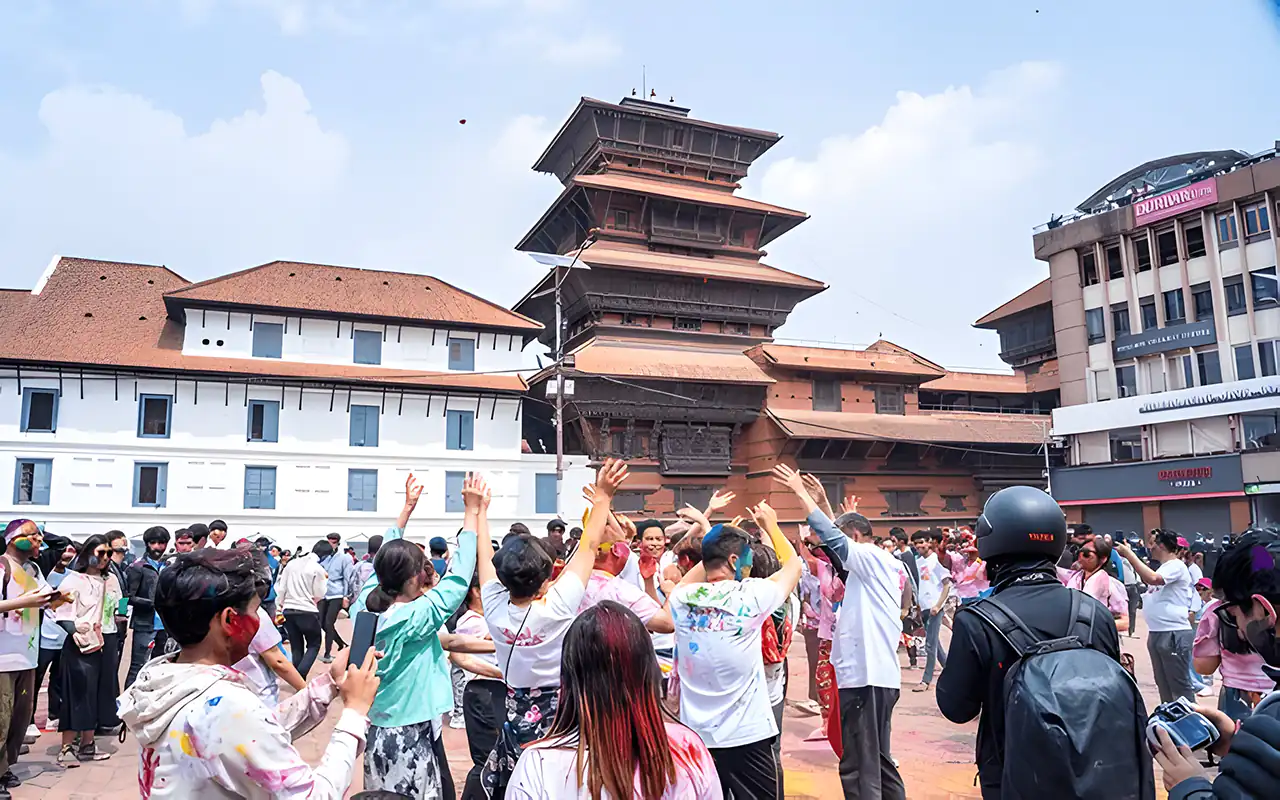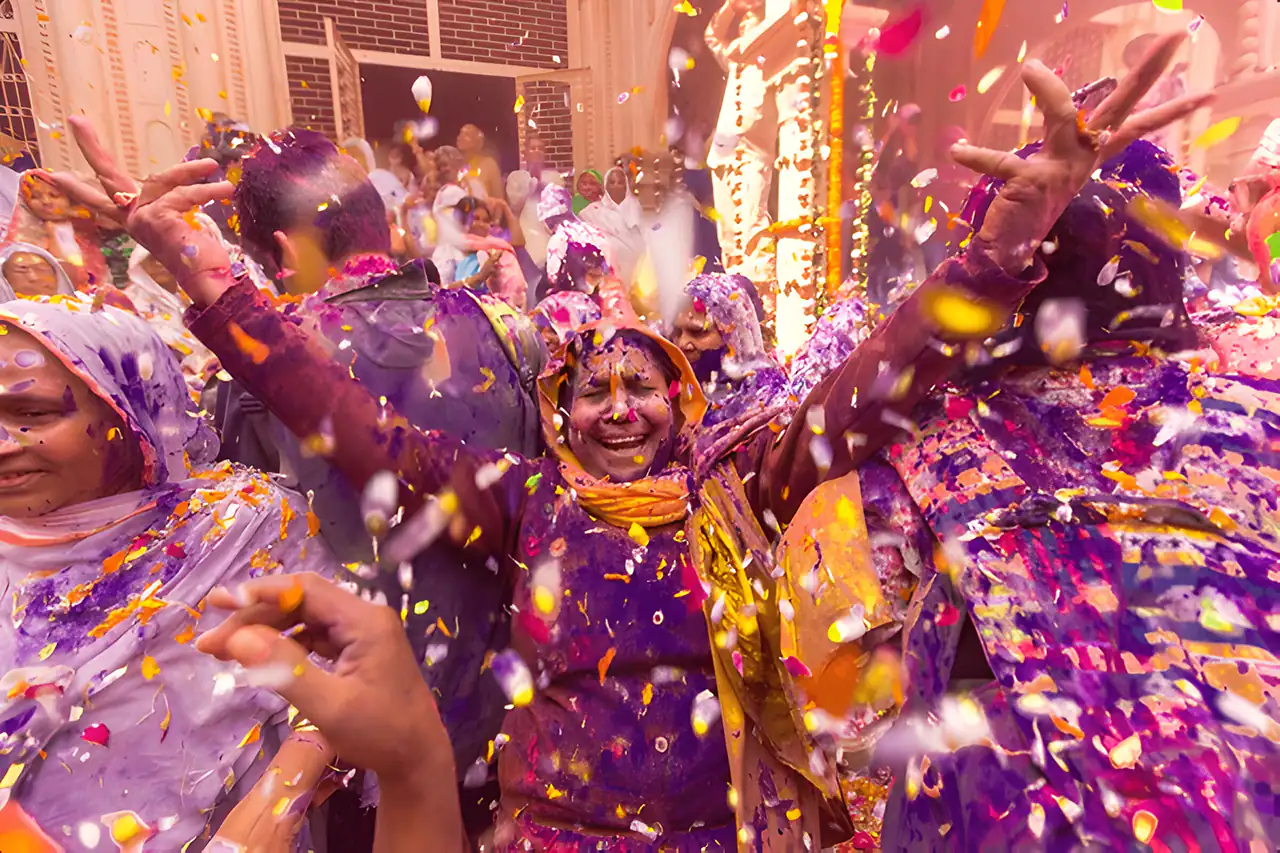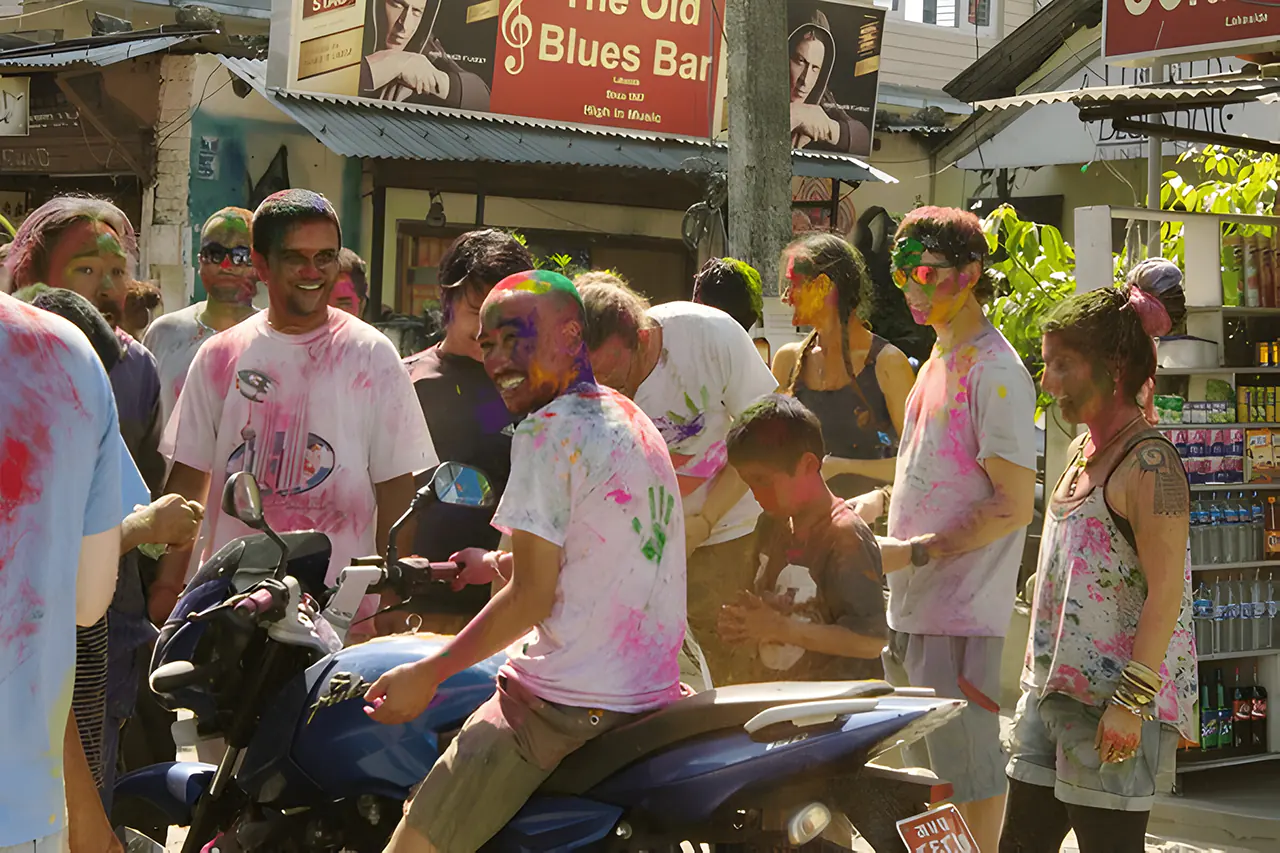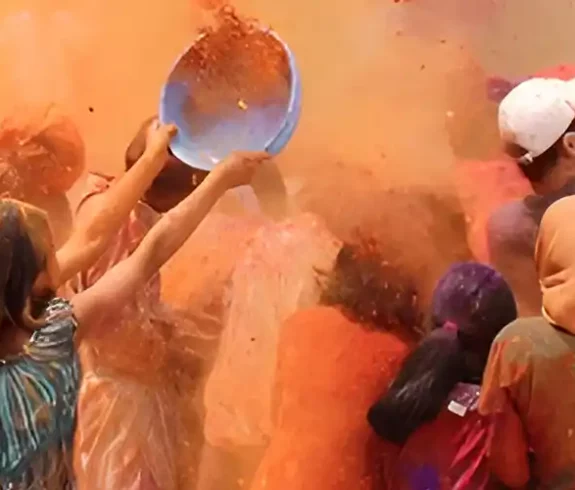The “Festival of Colors,” Holi, bursts with life as it welcomes the arrival of spring and commemorates the triumph of good over evil. Celebrated with great enthusiasm in India and Nepal, this festival’s vibrant spirit transcends borders, uniting people in a joyous spectacle of colors. This exuberant festival embodies the shedding of inhibitions, fostering a sense of unity and embracing the rejuvenating spirit of spring.
Ho li is more than an event marked by bright colors; it stands for the bond with nature and fascinates human beings to start afresh. The dazzling colors of the festival symbolize blooming flowers, ripening fruits, and the earth coming back to life after the quiet period of winter. Let us find out how Ho li joyfully brings in spring.

Holi’s Significance in Welcoming Spring:
- Light Conquers Darkness: This festival commemorates the victory of good over evil, symbolizing the dissipation of winter’s gloom and the welcome of spring’s radiant light and warmth.
- A Time for Renewal: The festival aligns with the vernal equinox, a period when nature transforms, shedding its old layers and bursting with new life. This festival mirrors this natural cycle, inspiring us to release the past and embrace fresh beginnings.
- Nature’s Palette: The lively colors used during this festival represent the blooming flowers, verdant fields, and the overall vibrancy that spring paints across the landscape. It visually celebrates nature’s rejuvenation and the abundance it promises.
- A Bountiful Harvest: Ho li also marks the harvest season in many parts of India. It’s a time to express gratitude for nature’s generosity and celebrate the fruits of hard work.
- Strengthening Bonds: The festival nurtures a sense of community and togetherness. People from all walks of life gather to celebrate, reinforcing social connections and creating cherished memories.
Historical and Cultural Background
Holi, known as the Festival of Colors, stands deeply rooted in centuries of Hindu mythology and cultural traditions. This festival celebrates spring’s arrival and embodies significant mythological stories and religious meanings, enriching its observance across various regions.
Mythological Roots of Holi
- The Story of Prahlad and Holika: This Ho li festival is about a boy named Prahlad and Holika, his aunt. This boy who adored Lord Vishnu was not ready to please his demon dad, Hiranyakashipu, who wanted people to worship him. Prahlad’s father commanded Holika, who was resistant to fire, to enter the flames with his son to kill him. Surprisingly, her immunity failed, and she perished in the fire. Meanwhile, Prahlad survived because of his righteousness. They burn flames during Holika Dahan to show they are happy about the victory of good against evildoers.
- The Love Story of Radha and Krishna: The playful dimension of this festival often reflects the love tale of Radha and Krishna. Legend has it that Krishna, self-conscious about his blue skin, mischievously smeared Radha with color to harmonize their complexions. This playful act initiated the exuberant celebration of Ho li, filled with dance, song, and the tossing of colored powders and water.
Religious Significance in Ancient Scripts
- References in Sacred Texts: The Puranas, Vedas, and Jaimini Mimansa, among ancient scriptures, chronicle Holi’s rituals and their philosophical importance, highlighting themes of unity, joy, and the victory of righteousness.
- Widespread Cultural Embrace: As time passed, this festival evolved beyond its religious roots, gaining popularity among South Asian communities and globally. The festival symbolizes the essential values of happiness, forgiveness, and relationship renewal.
Diverse Cultural Celebrations
This festival sees exuberant celebrations across different Indian states, each infusing its distinctive cultural essence into the festivities:
- In Uttar Pradesh, Mathura, and Vrindavan, sites linked with Krishna host grand rituals and performances during this festival, including the renowned Lathmar Holi, during which women playfully strike men with sticks.
- In Bengal: Known as Basant Utsav or Dol Jatra, this version of this festival celebrates Rabindranath Tagore’s songs, with participants engaging in dance and music to welcome the lively spring season.
- In Punjab: Here, this festival, termed Holla Mohalla, showcases Sikh martial arts prowess and is complemented by communal feasts.

Celebration Details of Holi: Colors, Cuisine, and Customs
Holi, the vibrant Festival of Colors, invites a flurry of preparations, rituals, and customs that are as colorful as the festival itself. This guide delves into how participants prepare for this festival, from crafting natural and synthetic colors to whipping traditional foods and drinks, and outlines the customary practices that define the festival.
Preparations: A Creative Outpouring
- Colors: From Nature’s Bounty to Synthetic Brilliance: The explosion of colors intertwines with his festival’s identity. Traditionally, people extracted natural colors from flowers, leaves, and roots. These organic pigments, like turmeric for yellow, beetroot for red, and indigo for blue, are gentle on the skin and kind to the environment. However, synthetic colors have gained popularity, offering a broader spectrum of dazzling shades.
- Traditional Treats: A Culinary Celebration: This festival is incomplete without various festive food and drinks. Gujiya, sweet dumplings stuffed with khoya (milk solids) and nuts, are delicious. The milk-based beverage thandai combines spices and nuts for a refreshing experience contrasting with the wild color play. Traditional snacks like the sweet and syrupy malpua, the tangy and refreshing dahi bhalla, and the savory and crispy mathri all contribute their unique flavors to the festive spread, further enhancing the joy of this festival celebration.
Rituals and Customs: A Rich Tapestry of Tradition
- Holika Dahan: A Bonfire of Triumph: On the eve of this festival, communities unite around a bonfire to commemorate the victory of good over evil, as exemplified in the legend of Holika and Prahlad. This ritual, known as Holika Dahan, symbolizes the burning away of negativity and the ushering in of spring’s positive energy.
- Playing with Colors: An Explosion of Joy: The heart of this festival lies in the exuberant act of drenching each other with colored powders and water. Water guns, or pichkaris, amplified the playful frenzy, creating a symphony of laughter and shared joy.
- Singing and Dancing: An Outpouring of Spirit: Music and dance are inseparable from these festivities. Traditional folk melodies and popular Bollywood tunes fill the air as people move to the rhythm and express their happiness through spontaneous dance.
Holi Greetings in English: Sharing Warm Wishes
While traditional Holi greetings often flow in Hindi or other regional languages, you can also express your heartfelt sentiments in English. Consider these warm wishes:
- “Happy Holi!”
- “Wishing you a vibrant and joyful Holi!”
- “May the colors of Holi fill your life with happiness and good fortune.”
Regional Variations of Holi: A Global Tapestry of Celebrations
People celebrate Holi with excitement and vibrant colors, following over a hundred traditions across different regions of India and other countries. The core meaning of Ho li remains unchanged; it signifies springtime cheer, romantic passions, and the victory of good against evil. Every place has its way of adding some touch to an event. Look at how these unique regional variations differ from one another.
India: A Melange of Colors and Customs
- North India: Lathmar Holi and Holi Milan: This festival takes on a playful and energetic form in northern states like Uttar Pradesh and Haryana. In Barsana, women playfully beat men with sticks in the famous Lathmar Holi, while Holi Milan in other regions sees communities come together for joyful reunions and color play.
- West Bengal: Dol Jatra and Basanta Utsav: In Bengal, this festival coincides with Dol Jatra, celebrating the divine love of Radha and Krishna. People swing idols of the deities on decorated swings, sing devotional songs, and enjoy a cultural extravaganza known as Basanta Utsav.
- Maharashtra and Gujarat: Rang Panchami and Dhuleti: In these western states, the main color play occurs on the fifth day after this festival, known as Rang Panchami. In Gujarat, people celebrate Dhuleti enthusiastically by forming human pyramids to reach a pot of buttermilk high above the streets.
- South India: While some communities celebrate this festival less widely, they observe it with their unique customs. In Kerala, the Konkani community celebrates Manjal Kuli using turmeric paste instead of colored powders.
Beyond India
- Nepal: A Week-Long Extravaganza: In Nepal, this festival, also known as Fagu Purnima, is celebrated for a whole week. The festivities include singing, dancing, and throwing colors, culminating in a grand finale on the full moon day.
- Other Countries: This festival has gained popularity in countries with significant Indian diaspora populations, such as the USA, UK, Canada, and Australia. People come together to celebrate their heritage, fostering community and cultural exchange.
Common Threads: The Universal Spirit
Despite the regional variations, specific common threads bind this festival celebrations across different cultures:
- Colors: The use of vibrant colors is a universal symbol of this festival, representing joy, love, and the arrival of spring.
- Community: This festival brings people together, transcending social barriers and fostering a sense of unity and belonging.
- New Beginnings: The festival signifies the shedding of the old and embracing new beginnings in nature and our lives.
- Triumph of Good: This festival celebrates the victory of good over evil, reminding us of the importance of righteousness and devotion.

Cultural Significance and Modern Celebrations
Holi, a vibrant “Festival of Colors,” has grown beyond its religious and cultural origins in India and Nepal, becoming a worldwide phenomenon. It is thus widely popular because of its deep meaning to the people and its versatility in meeting the needs of current times. We will examine this festival’s social effects and transformations in contemporary society.
Holi’s Cultural Significance: Weaving Unity and Renewal
- Breaking Down Barriers: This festival acts as a social leveler. During the festivities, people from all walks of life unite, regardless of their caste, creed, or social standing. The playful act of smearing each other with colors represents the dissolving of boundaries and celebrating our differences.
- Forgiveness and Fresh Starts: This festival encourages us to let go of past grievances and embrace new beginnings. It’s a time for reconciliation and strengthening connections with loved ones. The festival cultivates a sense of community and togetherness, reminding us of the importance of harmony and goodwill.
- A Tribute to Spring: As nature awakens from its winter sleep, this festival welcomes the arrival of spring with a burst of colors and joyous celebration. It’s a time to embrace the renewal and growth that the season brings, both in the natural world and within ourselves.
Modern Celebrations
- Organized Color Runs and Parties: The spirit of joy and color that defines this festival has inspired events organized worldwide, such as color runs and themed parties. These events provide a safe and nurtured environment for people to enjoy this festival without missing out on the traditional festival.
- Digital Connections: The digital age has amplified Holi’s reach and influence. Social media platforms come alive with colorful photos and videos, spreading the festive spirit worldwide. Online communities and virtual events allow people to connect and celebrate this festival, no matter where they are.
- A Cultural Melting Pot: This festival’s vibrant energy attracts people from diverse cultural backgrounds. As people from different communities join the festivities, it serves as a cultural exchange and understanding platform.
Safety and Environmental Concerns
Holi, known as the Festival of Colors, epitomizes joy and vibrancy. Addressing safety and environmental concerns is crucial to enjoying its colorful customs thoroughly. This guide provides actionable advice on celebrating this festival, emphasizing personal safety and environmental responsibility.
Safety Tips
- Choose Natural Dyes: Opt for natural dyes instead of synthetic ones to avoid skin irritations and allergic reactions. Turmeric, flowers, and beetroot create vibrant, safe colors for skin contact.
- Skin and Eye Protection: Before playing, apply a thick layer of oil or moisturizer to protect against the colors. Wear sunglasses to guard against harmful dyes and sunlight.
- Appropriate Attire: Wear old, comfortable clothes that cover most of your body. Opting for long-sleeved shirts and full pants will safeguard your skin.
Environmental Considerations
- Minimize Water Use: Since Ho li typically involves substantial water use, consider celebrating a dry festival or using less water by favoring color powders.
- Support Eco-Friendly Celebrations: Promote eco-friendly colors that are non-toxic and easy to wash off, thus preventing water pollution. Communities increasingly organize green Holi events highlighting natural color use and reduced water consumption.
Advancing Eco-Friendly Practices
- Raise Awareness: Educate your community about natural colors’ advantages for health and the environment. Motivate your friends and relatives to purchase or make their own eco-friendly Holi colors.
- Engage the Community: Get involved in or spearhead these festival events prioritizing eco-friendly practices. These gatherings can significantly diminish the festival’s environmental impact.
- Manage waste properly: Ensure proper garbage disposal after these festivities. Coordinate clean-up drives to remove color residues and other debris after the festival.

Personal Stories and Experiences
Holi is more than just a festival of colors; it’s a vibrant celebration where people joyfully dive into a riot of hues. It contains personal experiences and traditions of love and happiness that link to create homophony across human society. Below are some sweet stories and moments from those who have experienced the natural beauty of this festival.
Heartfelt Anecdotes of Holi Celebrations
- Family Gatherings and Traditional Games: Meera from Jaipur shares, “Every year, our family gathers to play traditional games like ‘Ras Kashi’ and ‘Holi Chaupad.’ This time together, filled with laughter and colors, strengthens our family bonds and creates lasting memories.”
- Memories of Childhood: Raj from Delhi recalls, ” This festival was always the highlight of the year in our neighborhood. We eagerly prepared water balloons days in advance, and the excitement built as we anticipated the festival. It wasn’t just about throwing colors but the community coming together.”
- Culinary Traditions: Ananya, a chef from Mumbai, expresses, “For me, cooking during this festival is as colorful as the festival itself. Preparing ‘gujiya’ and ‘thandai’ with my grandmother remains one of my fondest memories. These special recipes evoke nostalgia and bring everyone closer around the table.”
The Joy of Inclusivity and Community
- Unity in Diversity: Aamir from Lucknow reflects, “Holi is one festival where it doesn’t matter who you are or where you come from. Covered in colors, everyone looks the same, and that’s the beauty of it. This festival transcends social barriers and unites people in celebration.”
- International Experiences: Emily, an American living in India, shares her first Holi experience, “I found this festival mesmerizing. The happiness and openness of the people inviting me to the celebration were heartwarming. It reminded me of the simple joy that comes from human connection.”
Insights from the Festivities
- Sustainable Practices: Priya from Bengaluru highlights a growing trend: “Our family has switched to organic colors, embracing a more sustainable way to celebrate this festival. We see the festival remain vibrant while becoming more environmentally conscious.”
- Adapting Traditions: Neel from Kolkata comments on how this festival tradition evolved, “As we grew older, our Holi celebrations changed from using water guns to enjoying dry color play. Despite these changes, the core joy of the festival remains the same.”
Conclusion
As our exploration of the Festival of Colors draws close, it’s crucial to reflect on this festival’s deep cultural significance and the unity and joy it brings to communities globally. This festival transcends geographical and cultural boundaries, uniting people to celebrate life, love, and renewal.
The Cultural Importance
- Celebrating Virtue Over Vice: Holika Dahan marks the beginning of this festival, symbolizing the triumph of good over evil. This ritual encourages us to uphold virtue and righteousness, fostering a festive and positive atmosphere.
- Encouraging Renewal and Forgiveness: This festival emphasizes renewal and forgiveness at its core. The festival urges people to let go of old resentments, promoting reconciliation and new beginnings within communities.
- Promoting Joy and Inclusivity: By erasing social distinctions with splashes of color, this festival makes it impossible to differentiate by age, gender, caste, or creed. This erasure is a powerful reminder of our shared humanity and the collective joy of celebration.
Relevance of Holi in Today’s World
- Uniting Diverse Cultures: Holi’s message of unity and joy is increasingly pertinent in our globalized world. The festival teaches the importance of gathering to celebrate our similarities and differences in a world often divided.
- Worldwide Celebrations Connect Cultures: This festival has evolved into a global phenomenon, from color runs in the United States to vibrant parties across Europe and Asia, connecting diverse cultures through the universal language of festivity and color.
- Strengthening Community Ties: At its heart, this festival fosters community bonds. It is a delightful reason for people to come together, share meals, enjoy music, and create lasting memories.
- Adopting Sustainable Practices: Recent versions of Holi emphasize the importance of environmental preservation, using eco-friendly colors and measures to conserve water. Thus, people can happily celebrate the festival without harming Mother Earth.
